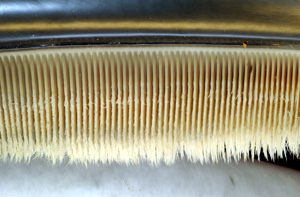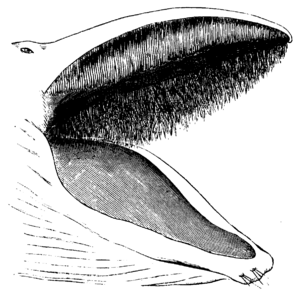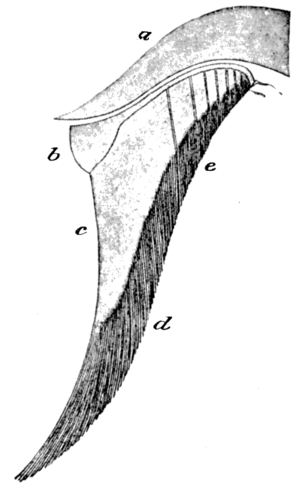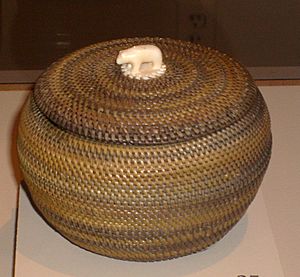Baleen facts for kids
Baleen is a special filter system found inside the mouths of baleen whales. To use it, a whale opens its mouth underwater to scoop in a lot of water. Then, the whale pushes the water out. Tiny animals like krill get caught by the baleen, staying inside the whale's mouth as food.
Baleen looks a bit like stiff bristles. It is made of keratin, which is the same stuff your fingernails, skin, and hair are made of! Some whales, like the bowhead whale, have baleen plates of different lengths. Other whales, like the gray whale, only use one side of their baleen. These bristles are arranged in plates across the top jaw of the whale.
A single baleen plate can be from about 0.5 to 3.5 meters (1.6 to 11.5 feet) long. It can weigh up to 90 kilograms (200 pounds). The hairy parts are called baleen hair or whalebone hair. These plates are wider at the bottom, where they attach to the whale's gums. People have compared baleen plates to sieves or Venetian blinds.
When people used baleen for different things, they usually called it whalebone. But this name is a bit misleading because baleen is not actually bone!
Contents
What Does "Baleen" Mean?
The word "baleen" comes from the Latin word bālaena. This word, and the Greek word phalaina, both mean "whale." So, the name simply means "whale part."
How Baleen Evolved Over Time
The oldest true fossils of baleen are about 15 million years old. But scientists think baleen started to appear much earlier than that. This is because they found clues in older whale skulls. These clues include special bone shapes in the upper jaw and loose lower jaw bones.
Scientists believe baleen first appeared around 30 million years ago. It might have developed from a hard, gummy upper jaw, similar to what a Dall's porpoise has today. This happened when Antarctica broke away from a supercontinent called Gondwana. This event created the Antarctic Circumpolar Current. This current helped make the ocean environments much richer in food, which was perfect for filter-feeding whales.
Whales probably didn't switch from having teeth to having baleen all at once. It was a gradual process. Modern baleen whales actually start with teeth when they are developing inside their mothers. But they lose these teeth and only have baleen by the time they are born and grow up. They even have a "fake gene" for tooth enamel, showing their ancestors used to have teeth.
Some ancient whales, like Aetiocetus, might have had both teeth and baleen at the same time. This would have been a step between whales with only teeth and whales with only baleen. This idea is supported by other changes that happened as baleen evolved, like changes in skull shape and throat flexibility. These changes made it possible for whales to filter feed. This means that these ancient whales could use new ways to find food while still using their old methods.
How Whales Use Baleen to Eat
A whale's baleen plates are super important for how it eats. To feed, a baleen whale opens its mouth very wide. It scoops up huge groups of tiny prey, like krill, small fish, and even copepods, along with a lot of water.
Then, the whale partly closes its mouth. It pushes its big tongue against its upper jaw. This forces the water out through the baleen plates on the sides of its mouth. The baleen acts like a giant sieve, trapping all the tiny food inside. The whale then swallows its meal!
How People Used Baleen
In the past, people used baleen (which they called "whalebone") for many things. It was popular because it was strong but also flexible. People made items like baskets, backscratchers, and parts for clothing like corsets and crinoline petticoats. It was also used for buggy whips and even parts of cable-backed bows.
Today, we use man-made materials like plastic and fiberglass for similar purposes. In the United States, a law called the Marine Mammal Protection Act was passed in 1972. This law makes it illegal to buy, sell, or transport any marine mammal or marine mammal product, including baleen.
Images for kids
-
A Gray whale calf with its mouth open, showing its baleen.






